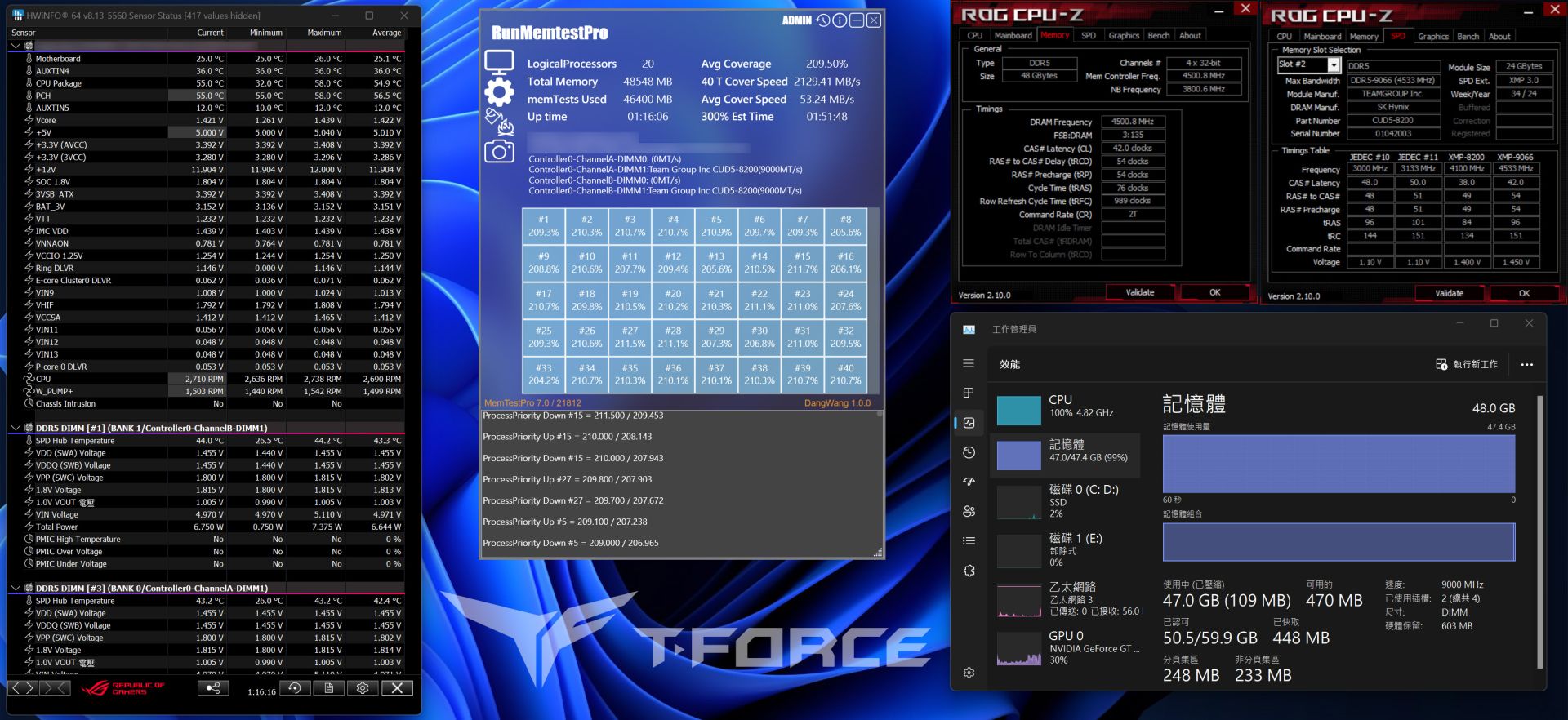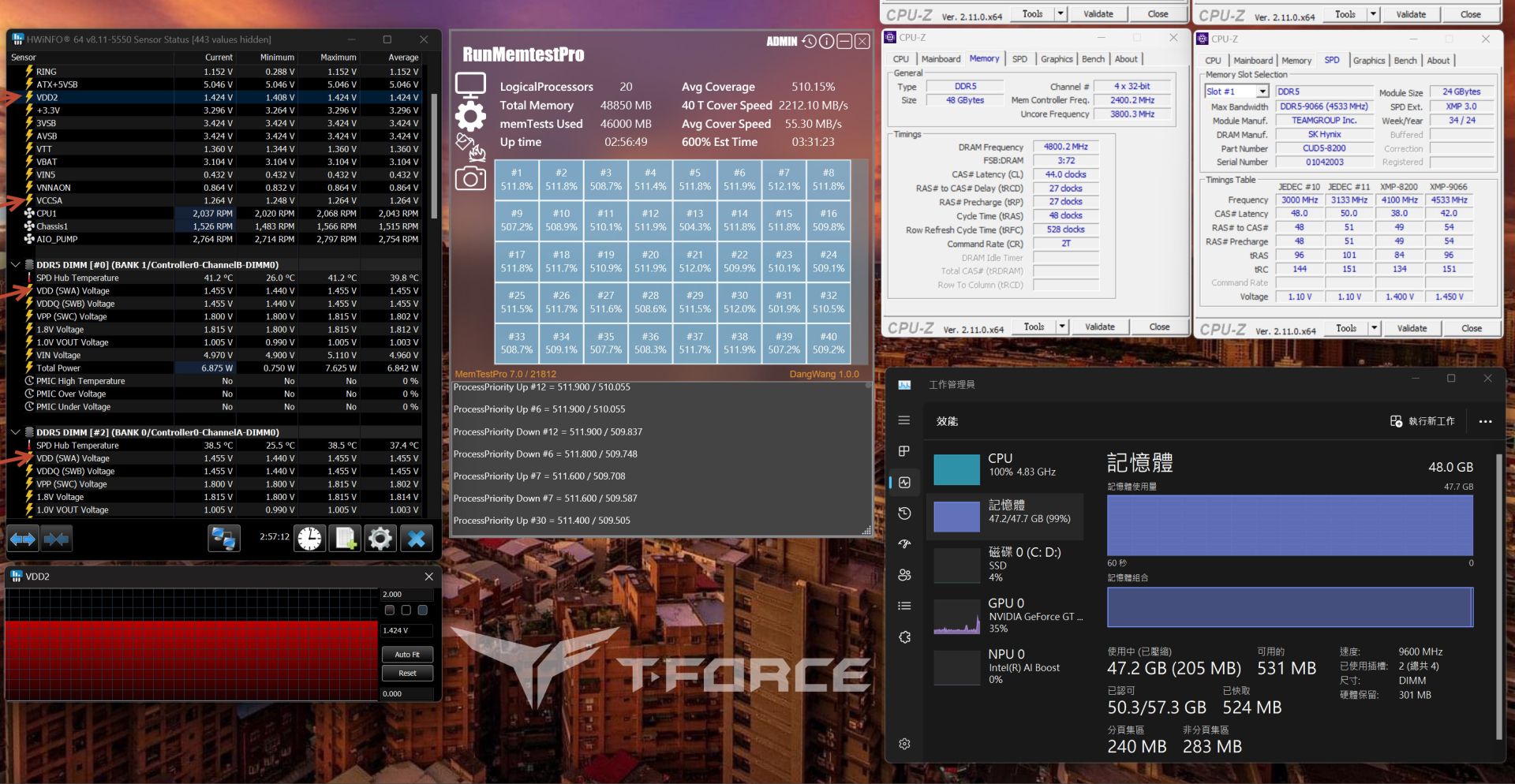TeamGroup rolls out CUDIMMs up to DDR5-9600 for Intel Arrow Lake CPUs — clock driver enables massive overclocking
Core Ultra 200 CPUs get very fast RAM.

TeamGroup has introduced its family of clock-unbuffered memory modules (CUDIMMs) that promise to significantly enhance memory performance on Intel's latest Core Ultra 200S-series platforms. TeamGroup's flagship T-Force Xtreem CKD DDR5 modules boast a data transfer of DDR5-9000 and overclocking potential up to DDR5-9600.
TeamGroup's initial family of T-Force Xtreem CKD DDR5 offerings will include dual-channel 48GB kits (2x24GB modules) rated for DDR5-8200 – DDR5-9000 data transfer rates (Gear 2) and designed to work with Intel's Core Ultra 200S-series 'Arrow Lake-S' processors on Intel Z890-based motherboards.
TeamGroup says that those who want to go beyond a DDR5-9000 speed, say, to DDR5-9600, can do so, but only in Gear 4 mode, which means that the Arrow Lake-S memory controller will function at ¼ of memory's speed (2400 MHz), which is not optimal for the majority of applications. Also, with Gear 4, installing four T-Force Xtreem CKD DDR5 modules running at an 8800 MT/s data transfer rate will be possible.
TeamGroup's range-topping T-Force Xtreem CKD DDR5 modules have black aluminum heatsinks to match the designs of most modern setups and feature Intel's XMP 3.0 profiles for quickly setting the right speeds and timings.


The main selling feature of these CUDIMMs is the onboard clock driver (CKD) chip that takes in a base clock signal and distributes it to the different memory components on the module. To maintain signal integrity, it buffers and amplifies the clock signal, effectively regenerating it to ensure it reaches all components with its strength intact, which is how CUDIMMs enable higher data transfer rates.
Additionally, the CKD incorporates features such as duty cycle correction for accurate timing and jitter reduction to reduce variations in the clock signal's timing to ensure high performance and utmost stability.
TeamGroup says that its T-Force Xtreem CKD DDR5 memory modules will be available but does not disclose when. Yet, it is reasonable to expect them to hit the market sooner rather than later, as Intel's new-generation processors for enthusiasts are already here. Pricing is another factor, of course. A CKD chip itself does not cost a lot, but it requires redesigning a memory module, which is a complex task.
Get Tom's Hardware's best news and in-depth reviews, straight to your inbox.

Anton Shilov is a contributing writer at Tom’s Hardware. Over the past couple of decades, he has covered everything from CPUs and GPUs to supercomputers and from modern process technologies and latest fab tools to high-tech industry trends.
-
thestryker Another announcement that isn't particularly meaningful since they don't have dates either. So far none of the CUDIMM announcements have given time frames (Adata did say Q4, but we're already there and it's through the end of the year so minimally useful). Corsair, Kingston and G.Skill haven't made announcements at all for their products.Reply
It's unfortunate that the timing on CUDIMMs hasn't really worked out for the ARL launch. It sounds like Asus was sending out some with review kits, but I haven't seen anything with regards to Intel. At least we'll have an idea of expected performance but not being able to buy the best memory as the platform launches is pretty bad. -
mac_angel I'm trying to understand the CUDIMM. It's suppose to be compatible with regular DDR5 slots. Does that mean previous generation CPUs can use CUDIMMs, too? Maybe with a BIOS update?Reply -
thestryker Reply
From what I understand the IMC effectively needs to be able to understand what to do with the client clock driver. The CUDIMM compatibility on AMD motherboards currently is limited to Zen 5 and in bypass mode which means ignoring the CKD which is the whole point behind getting CUDIMMs in the first place.mac_angel said:I'm trying to understand the CUDIMM. It's suppose to be compatible with regular DDR5 slots. Does that mean previous generation CPUs can use CUDIMMs, too? Maybe with a BIOS update?
I believe the reason they've implemented bypass is that JEDEC mandates a CKD be present in anything that adheres to their 6400 or higher speed specifications. This should mean over time more and more of the memory kits sold should be CUDIMMs and since AMD has promised support on AM5 through 2027 it would make sense that they would want to be able to just use whatever memory was on the market whether or not it can take advantage of the CKD. -
TheHerald Reply
You can use them, you can't take advantage of them. Previous generation cpus can't communicate with the ckd so you have to run them in bypass mode.mac_angel said:I'm trying to understand the CUDIMM. It's suppose to be compatible with regular DDR5 slots. Does that mean previous generation CPUs can use CUDIMMs, too? Maybe with a BIOS update?
Ckd introduces extra latency, so in order for them to be worthy you need to run higher speeds than normal dims anyways. And since older platforms can't really run over 8k, they are kinda pointless for 12th,13th and 14th gen